

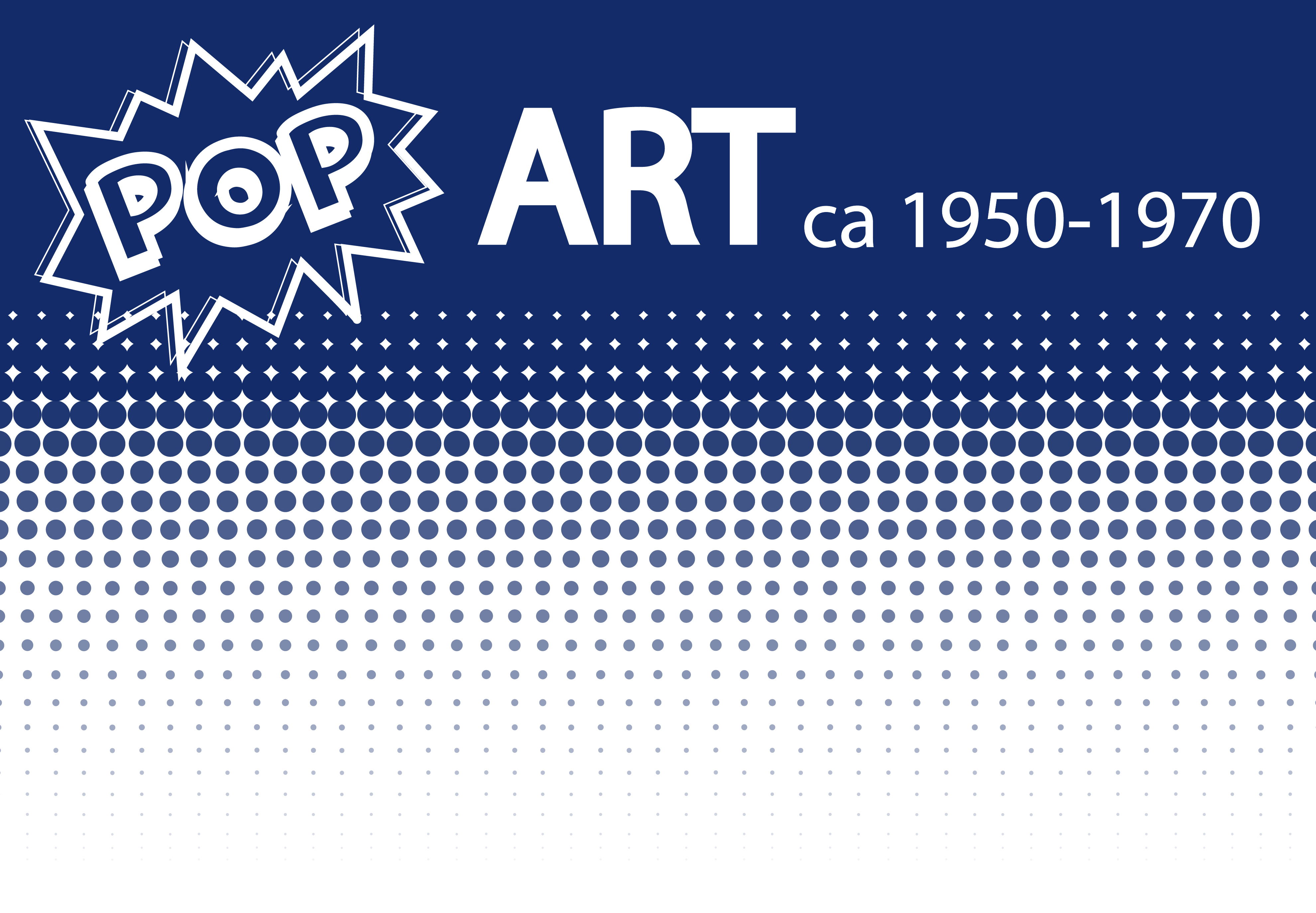
You might associate Pop Art with comic books and the artist Andy Warhol with his distinctive visual expression. But let us delve a little deeper into the movement and discover the story behind its origin.
The term Pop Art was invented by Lawrence Alloway in 1955. Alloway was a British curator, and the term described a new form of “popular” art. Pop art is an art movement that first emerged in the United Kingdom and the United States during the mid-1950’s. It paralleled with the growth of pop music and youth culture. Icons such as Elvis and Marilyn Monroe were used to personify the era. The Pop Art movement was affected by the horror and pain caused by the Second World War, which is why the era is characterized by the strong sense of optimism that raised in Europe and the United States during the Post-War time. At the same time, there was a strong economic growth in both Europe and the US, and a consumeristic culture emerged. This is often referred to as the “Post-War consumer boom”. The Pop Art movement was a reaction against the emerging of the mass-production and mass-culture caused by this. Typically, pop art display works inspired by mass culture and everyday objects, commercial items, cultural icons, and product labels, celebrities, Coca-Cola labels and other popular products.
 Pop Art is meant to be fun, which is reflected in its characteristics with fun patterns, strong colors and flat image, it often resembles the style and look of the classic comic stripes. As already mentioned, the movement was a reaction against the consumer-boom, but it was also in many ways a reaction against the seriousness of Abstract Expressionist Art, which was the dominant artistic movement in the 1950’s.
Pop Art is meant to be fun, which is reflected in its characteristics with fun patterns, strong colors and flat image, it often resembles the style and look of the classic comic stripes. As already mentioned, the movement was a reaction against the consumer-boom, but it was also in many ways a reaction against the seriousness of Abstract Expressionist Art, which was the dominant artistic movement in the 1950’s.
Abstract expressionists delve deeply into the personal, the individual psyche while in pop art the artists tend to look out towards the objects of the world. Pop Art was in many ways a cultural rebellion, which was hostile to the artistic establishment. Pop Art was somehow an attempt to return to a more objective form of art after the powerful dominance of the highly personal abstract expressionism and other pretensions art forms of the past. So, what are the most significant characteristics of the era? The Pop Art Movement strived to smudge the line between “high” art and “low” culture. They were motivated by the idea that there should be no hierarchy of culture, and by creating art works inspired by mass media objects they created the concept that art may borrow ideas from any source, which is one of the most influential characteristics of Pop Art.
 Moving on to characteristics regarding style and look; one of the basic ideas behind Pop Art was to create a form of art with instant meaning that would appeal to the majority of the public, which was also a contrast to previous eras of art. Pop artists typically experimented a lot with different media and mixed media in order to achieve their goal of instant meaning. They used acrylic painting, collage, silkscreen printing etc. They also used easily recognizable color schemes, inspired by television, cartoons and comic books. They often used highly-contrasting colors and the compositions of the art works were often very simple and appealing to most people. They also typically used simple patterns such as dots and lines, which are very recognizable for the era. Now, let us move on and learn more about some of the most significant designers/artists of the time.
Moving on to characteristics regarding style and look; one of the basic ideas behind Pop Art was to create a form of art with instant meaning that would appeal to the majority of the public, which was also a contrast to previous eras of art. Pop artists typically experimented a lot with different media and mixed media in order to achieve their goal of instant meaning. They used acrylic painting, collage, silkscreen printing etc. They also used easily recognizable color schemes, inspired by television, cartoons and comic books. They often used highly-contrasting colors and the compositions of the art works were often very simple and appealing to most people. They also typically used simple patterns such as dots and lines, which are very recognizable for the era. Now, let us move on and learn more about some of the most significant designers/artists of the time.
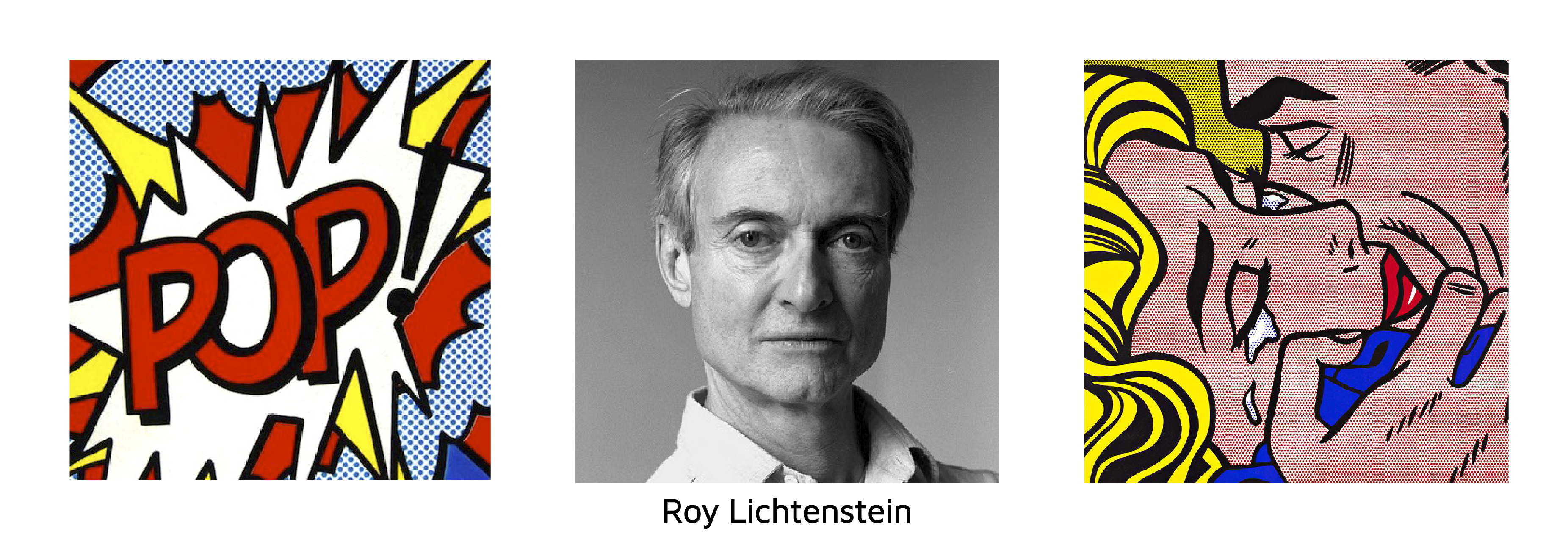
Roy Lichtenstein (1923-1997) was an American painter, sculptor and lithographer. Through his work, Lichtenstein became a leading figure in the Pop Art movement. With his bright, boldly colored graphic works, Lichtenstein parodied American popular culture, consumerism and the art world itself.
In his younger years, he had a passion for science, comic books and art. He carried on to study art, but his college studies were interrupted by the war, when he was sent to Europe in 1943 to serve in World War II. Three years later, Lichtenstein returned to America to finish his master’s degree in fine arts. After his studies, he moved on to work as an industrial designer and commercial-art instructor. In the late 1940’s, Lichtenstein had his first nationwide art exhibitions. At this time, he typically used subjects from American history and folklore, and presented them in styles of art from the 18th century-modernism. A few years later, in the early 1960’s, he began to experiment with different subjects and methods. These works were a reaction against American popular culture and of Abstract Expressionist art.
While in Abstract Expressionism, artists would usually emphasize on their own inner emotions and feelings in their art, Lichtenstein would take subjects straight from comic books and advertisements and mimic his borrowed sources down to an impersonal-looking stencil process that imitated the mechanical printing used for commercial art. His work from this time often featured well-known cartoon characters like Mickey Mouse and Donald Duck, as well as subjects from food-advertisement and popular house hold products. Lichtenstein became famous for his sense of humor and the signature he built using mass-produced images in his works. By 1965, he was nationally well-known as an artist and as one of the leaders of the Pop Art movement. In the 1970’s his focus turned from comic book sources to art from great painters such as Picasso, Matisse and Salvador Dali. Through the next decades until his death in 1997, he was also inspired by modern house interiors, mirror reflections, sculpting – all in his trademark, cartoonish style.
About his way of using sources of existing works, Lichtenstein said: “I’m never drawing the object itself; I’m only drawing a depiction of the object – a kind of crystallized symbol of it”. He received several honorary degrees and awards and will always be remembered as one of the most influential artists of the Pop Art movement.
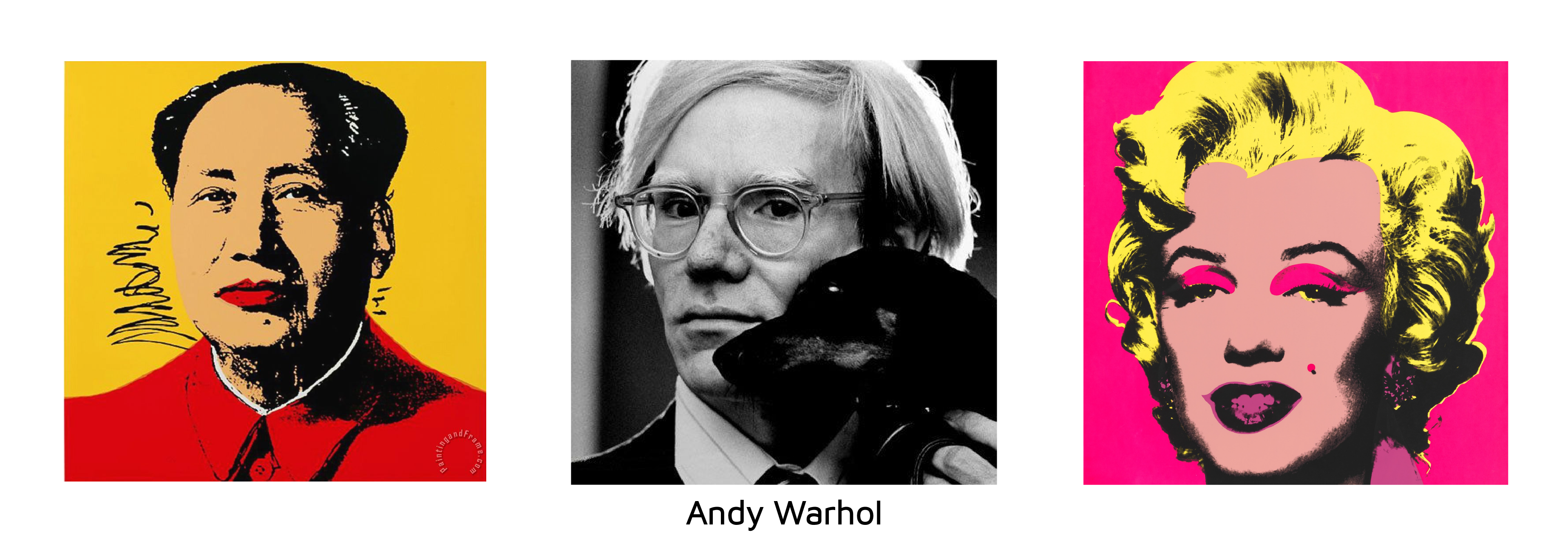







You might associate Pop Art with comic books and the artist Andy Warhol with his distinctive visual expression. But let us delve a little deeper into the movement and discover the story behind its origin.
The term Pop Art was invented by Lawrence Alloway in 1955. Alloway was a British curator, and the term described a new form of “popular” art. Pop art is an art movement that first emerged in the United Kingdom and the United States during the mid-1950’s. It paralleled with the growth of pop music and youth culture. Icons such as Elvis and Marilyn Monroe were used to personify the era. The Pop Art movement was affected by the horror and pain caused by the Second World War, which is why the era is characterized by the strong sense of optimism that raised in Europe and the United States during the Post-War time. At the same time, there was a strong economic growth in both Europe and the US, and a consumeristic culture emerged. This is often referred to as the “Post-War consumer boom”. The Pop Art movement was a reaction against the emerging of the mass-production and mass-culture caused by this. Typically, pop art display works inspired by mass culture and everyday objects, commercial items, cultural icons, and product labels, celebrities, Coca-Cola labels and other popular products.
 Pop Art is meant to be fun, which is reflected in its characteristics with fun patterns, strong colors and flat image, it often resembles the style and look of the classic comic stripes. As already mentioned, the movement was a reaction against the consumer-boom, but it was also in many ways a reaction against the seriousness of Abstract Expressionist Art, which was the dominant artistic movement in the 1950’s.
Pop Art is meant to be fun, which is reflected in its characteristics with fun patterns, strong colors and flat image, it often resembles the style and look of the classic comic stripes. As already mentioned, the movement was a reaction against the consumer-boom, but it was also in many ways a reaction against the seriousness of Abstract Expressionist Art, which was the dominant artistic movement in the 1950’s.
Abstract expressionists delve deeply into the personal, the individual psyche while in pop art the artists tend to look out towards the objects of the world. Pop Art was in many ways a cultural rebellion, which was hostile to the artistic establishment. Pop Art was somehow an attempt to return to a more objective form of art after the powerful dominance of the highly personal abstract expressionism and other pretensions art forms of the past. So, what are the most significant characteristics of the era? The Pop Art Movement strived to smudge the line between “high” art and “low” culture. They were motivated by the idea that there should be no hierarchy of culture, and by creating art works inspired by mass media objects they created the concept that art may borrow ideas from any source, which is one of the most influential characteristics of Pop Art.
 Moving on to characteristics regarding style and look; one of the basic ideas behind Pop Art was to create a form of art with instant meaning that would appeal to the majority of the public, which was also a contrast to previous eras of art. Pop artists typically experimented a lot with different media and mixed media in order to achieve their goal of instant meaning. They used acrylic painting, collage, silkscreen printing etc. They also used easily recognizable color schemes, inspired by television, cartoons and comic books. They often used highly-contrasting colors and the compositions of the art works were often very simple and appealing to most people. They also typically used simple patterns such as dots and lines, which are very recognizable for the era. Now, let us move on and learn more about some of the most significant designers/artists of the time.
Moving on to characteristics regarding style and look; one of the basic ideas behind Pop Art was to create a form of art with instant meaning that would appeal to the majority of the public, which was also a contrast to previous eras of art. Pop artists typically experimented a lot with different media and mixed media in order to achieve their goal of instant meaning. They used acrylic painting, collage, silkscreen printing etc. They also used easily recognizable color schemes, inspired by television, cartoons and comic books. They often used highly-contrasting colors and the compositions of the art works were often very simple and appealing to most people. They also typically used simple patterns such as dots and lines, which are very recognizable for the era. Now, let us move on and learn more about some of the most significant designers/artists of the time.

Roy Lichtenstein (1923-1997) was an American painter, sculptor and lithographer. Through his work, Lichtenstein became a leading figure in the Pop Art movement. With his bright, boldly colored graphic works, Lichtenstein parodied American popular culture, consumerism and the art world itself.
In his younger years, he had a passion for science, comic books and art. He carried on to study art, but his college studies were interrupted by the war, when he was sent to Europe in 1943 to serve in World War II. Three years later, Lichtenstein returned to America to finish his master’s degree in fine arts. After his studies, he moved on to work as an industrial designer and commercial-art instructor. In the late 1940’s, Lichtenstein had his first nationwide art exhibitions. At this time, he typically used subjects from American history and folklore, and presented them in styles of art from the 18th century-modernism. A few years later, in the early 1960’s, he began to experiment with different subjects and methods. These works were a reaction against American popular culture and of Abstract Expressionist art.
While in Abstract Expressionism, artists would usually emphasize on their own inner emotions and feelings in their art, Lichtenstein would take subjects straight from comic books and advertisements and mimic his borrowed sources down to an impersonal-looking stencil process that imitated the mechanical printing used for commercial art. His work from this time often featured well-known cartoon characters like Mickey Mouse and Donald Duck, as well as subjects from food-advertisement and popular house hold products. Lichtenstein became famous for his sense of humor and the signature he built using mass-produced images in his works. By 1965, he was nationally well-known as an artist and as one of the leaders of the Pop Art movement. In the 1970’s his focus turned from comic book sources to art from great painters such as Picasso, Matisse and Salvador Dali. Through the next decades until his death in 1997, he was also inspired by modern house interiors, mirror reflections, sculpting – all in his trademark, cartoonish style.
About his way of using sources of existing works, Lichtenstein said: “I’m never drawing the object itself; I’m only drawing a depiction of the object – a kind of crystallized symbol of it”. He received several honorary degrees and awards and will always be remembered as one of the most influential artists of the Pop Art movement.

Andy Warhol is perhaps the most known figure related to Pop-Art, many people associate the era with his name and distinctive work. He was born on August 6, 1928, in Pittsburg, Pennsylvania where he was raised in a working-class family. Andy was a hard worker, and he became a successful artist, director, producer and commercial illustrator, as well as a leading figure in the pop-art movement. His distinctive work in the 60’s expresses the relationship between pop/celebrity culture and advertising through his own artistic expression. He work with a large variety of media, such as film, painting, photography, sculpture, silkscreening and more. Already in the late 1950’s Andy began exhibiting how works in multiple galleries, leading to high recognition for his work, and becoming a influential and controversial artist of the time. Later, he started working as a producer and he eventually also authored numerous successful books. After an impressive life and career, Warhol unfortunately died at the early age of 58, due to a sickness.
Andy Warhol became a historical person who most people know to this day. He has been the subject of several exhibitions even after his death, books have been written in his honor and documentary films have been made as well. There is even a museum, known as “The Andy Warhol Museum” in his hometown of Pittsburg, which holds an impressive collection of art. It is the largest museum in the US dedicated to a single artist – though it is well earned. Many of his works are highly attractive and valuable to this day – the highest price for a Warhol painting ever sold was at 105 million US dollars. This was a painting on canvas titled “Silver Car Crash”. Some of his other most famous works are “Campbell’s Soup Cans” and “Marilyn Diptych”.







You might associate Pop Art with comic books and the artist Andy Warhol with his distinctive visual expression. But let us delve a little deeper into the movement and discover the story behind its origin.
The term Pop Art was invented by Lawrence Alloway in 1955. Alloway was a British curator, and the term described a new form of “popular” art. Pop art is an art movement that first emerged in the United Kingdom and the United States during the mid-1950’s. It paralleled with the growth of pop music and youth culture. Icons such as Elvis and Marilyn Monroe were used to personify the era. The Pop Art movement was affected by the horror and pain caused by the Second World War, which is why the era is characterized by the strong sense of optimism that raised in Europe and the United States during the Post-War time. At the same time, there was a strong economic growth in both Europe and the US, and a consumeristic culture emerged. This is often referred to as the “Post-War consumer boom”. The Pop Art movement was a reaction against the emerging of the mass-production and mass-culture caused by this. Typically, pop art display works inspired by mass culture and everyday objects, commercial items, cultural icons, and product labels, celebrities, Coca-Cola labels and other popular products.
 Pop Art is meant to be fun, which is reflected in its characteristics with fun patterns, strong colors and flat image, it often resembles the style and look of the classic comic stripes. As already mentioned, the movement was a reaction against the consumer-boom, but it was also in many ways a reaction against the seriousness of Abstract Expressionist Art, which was the dominant artistic movement in the 1950’s.
Pop Art is meant to be fun, which is reflected in its characteristics with fun patterns, strong colors and flat image, it often resembles the style and look of the classic comic stripes. As already mentioned, the movement was a reaction against the consumer-boom, but it was also in many ways a reaction against the seriousness of Abstract Expressionist Art, which was the dominant artistic movement in the 1950’s.
Abstract expressionists delve deeply into the personal, the individual psyche while in pop art the artists tend to look out towards the objects of the world. Pop Art was in many ways a cultural rebellion, which was hostile to the artistic establishment. Pop Art was somehow an attempt to return to a more objective form of art after the powerful dominance of the highly personal abstract expressionism and other pretensions art forms of the past. So, what are the most significant characteristics of the era? The Pop Art Movement strived to smudge the line between “high” art and “low” culture. They were motivated by the idea that there should be no hierarchy of culture, and by creating art works inspired by mass media objects they created the concept that art may borrow ideas from any source, which is one of the most influential characteristics of Pop Art.
 Moving on to characteristics regarding style and look; one of the basic ideas behind Pop Art was to create a form of art with instant meaning that would appeal to the majority of the public, which was also a contrast to previous eras of art. Pop artists typically experimented a lot with different media and mixed media in order to achieve their goal of instant meaning. They used acrylic painting, collage, silkscreen printing etc. They also used easily recognizable color schemes, inspired by television, cartoons and comic books. They often used highly-contrasting colors and the compositions of the art works were often very simple and appealing to most people. They also typically used simple patterns such as dots and lines, which are very recognizable for the era. Now, let us move on and learn more about some of the most significant designers/artists of the time.
Moving on to characteristics regarding style and look; one of the basic ideas behind Pop Art was to create a form of art with instant meaning that would appeal to the majority of the public, which was also a contrast to previous eras of art. Pop artists typically experimented a lot with different media and mixed media in order to achieve their goal of instant meaning. They used acrylic painting, collage, silkscreen printing etc. They also used easily recognizable color schemes, inspired by television, cartoons and comic books. They often used highly-contrasting colors and the compositions of the art works were often very simple and appealing to most people. They also typically used simple patterns such as dots and lines, which are very recognizable for the era. Now, let us move on and learn more about some of the most significant designers/artists of the time.
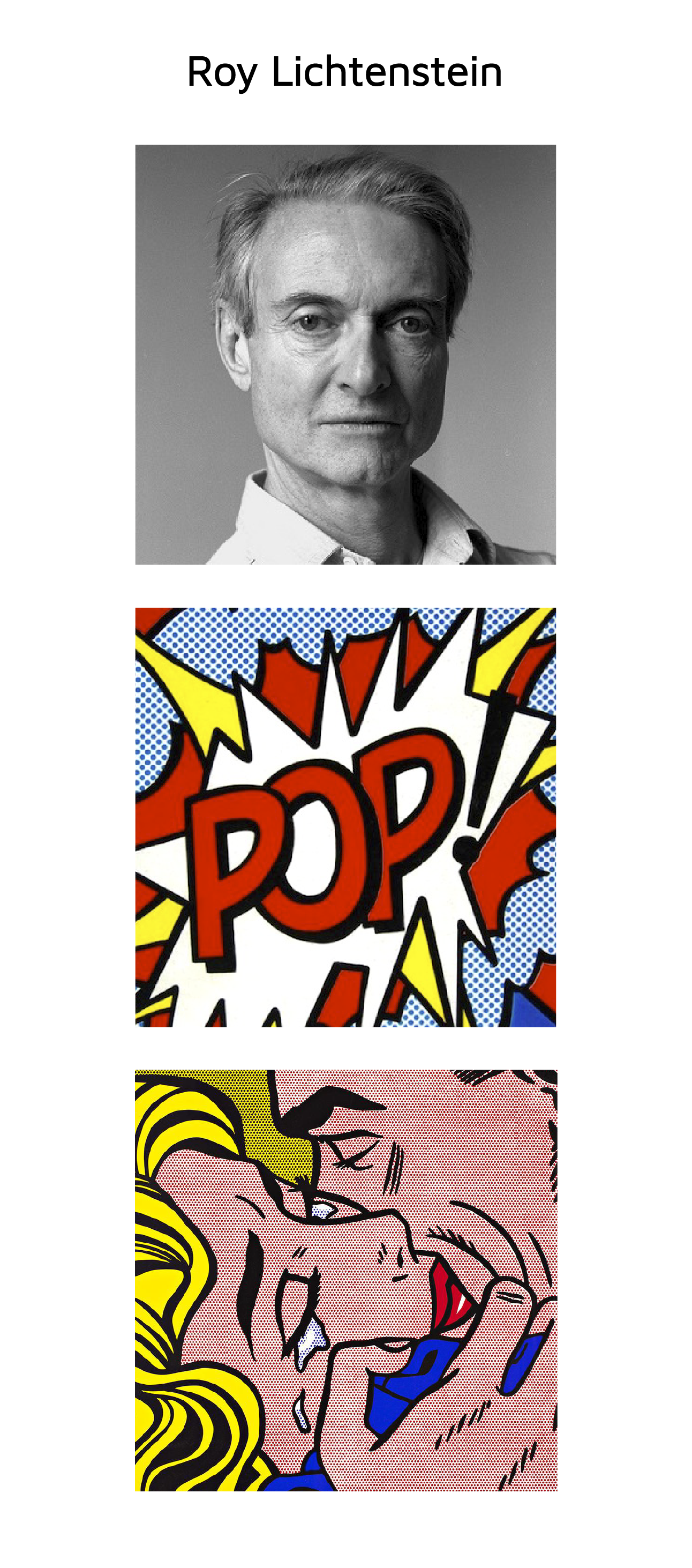
Roy Lichtenstein (1923-1997) was an American painter, sculptor and lithographer. Through his work, Lichtenstein became a leading figure in the Pop Art movement. With his bright, boldly colored graphic works, Lichtenstein parodied American popular culture, consumerism and the art world itself.
In his younger years, he had a passion for science, comic books and art. He carried on to study art, but his college studies were interrupted by the war, when he was sent to Europe in 1943 to serve in World War II. Three years later, Lichtenstein returned to America to finish his master’s degree in fine arts. After his studies, he moved on to work as an industrial designer and commercial-art instructor. In the late 1940’s, Lichtenstein had his first nationwide art exhibitions. At this time, he typically used subjects from American history and folklore, and presented them in styles of art from the 18th century-modernism. A few years later, in the early 1960’s, he began to experiment with different subjects and methods. These works were a reaction against American popular culture and of Abstract Expressionist art.
While in Abstract Expressionism, artists would usually emphasize on their own inner emotions and feelings in their art, Lichtenstein would take subjects straight from comic books and advertisements and mimic his borrowed sources down to an impersonal-looking stencil process that imitated the mechanical printing used for commercial art. His work from this time often featured well-known cartoon characters like Mickey Mouse and Donald Duck, as well as subjects from food-advertisement and popular house hold products. Lichtenstein became famous for his sense of humor and the signature he built using mass-produced images in his works. By 1965, he was nationally well-known as an artist and as one of the leaders of the Pop Art movement. In the 1970’s his focus turned from comic book sources to art from great painters such as Picasso, Matisse and Salvador Dali. Through the next decades until his death in 1997, he was also inspired by modern house interiors, mirror reflections, sculpting – all in his trademark, cartoonish style.
About his way of using sources of existing works, Lichtenstein said: “I’m never drawing the object itself; I’m only drawing a depiction of the object – a kind of crystallized symbol of it”. He received several honorary degrees and awards and will always be remembered as one of the most influential artists of the Pop Art movement.
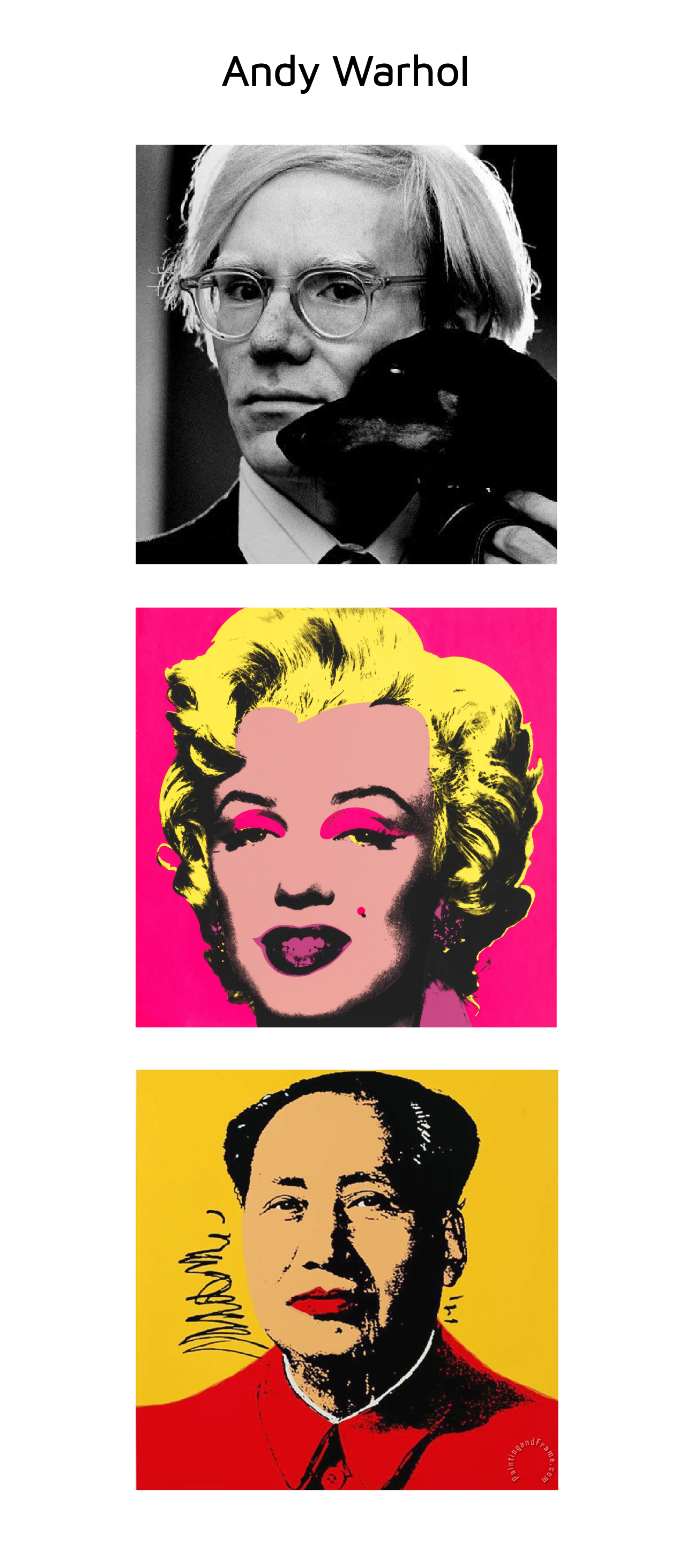
Andy Warhol is perhaps the most known figure related to Pop-Art, many people associate the era with his name and distinctive work. He was born on August 6, 1928, in Pittsburg, Pennsylvania where he was raised in a working-class family. Andy was a hard worker, and he became a successful artist, director, producer and commercial illustrator, as well as a leading figure in the pop-art movement. His distinctive work in the 60’s expresses the relationship between pop/celebrity culture and advertising through his own artistic expression. He work with a large variety of media, such as film, painting, photography, sculpture, silkscreening and more. Already in the late 1950’s Andy began exhibiting how works in multiple galleries, leading to high recognition for his work, and becoming a influential and controversial artist of the time. Later, he started working as a producer and he eventually also authored numerous successful books. After an impressive life and career, Warhol unfortunately died at the early age of 58, due to a sickness.
Andy Warhol became a historical person who most people know to this day. He has been the subject of several exhibitions even after his death, books have been written in his honor and documentary films have been made as well. There is even a museum, known as “The Andy Warhol Museum” in his hometown of Pittsburg, which holds an impressive collection of art. It is the largest museum in the US dedicated to a single artist – though it is well earned. Many of his works are highly attractive and valuable to this day – the highest price for a Warhol painting ever sold was at 105 million US dollars. This was a painting on canvas titled “Silver Car Crash”. Some of his other most famous works are “Campbell’s Soup Cans” and “Marilyn Diptych”.
